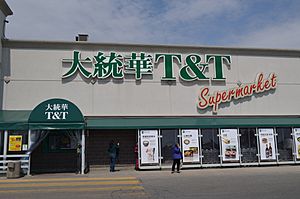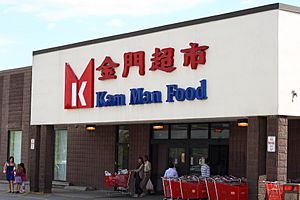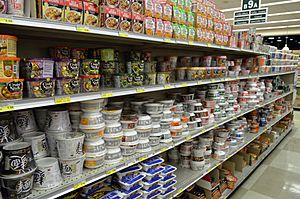Asian supermarket facts for kids
In countries outside of Asia, an Asian supermarket is a special kind of grocery store. These stores mainly sell foods and products imported from countries in the Far East. This includes places like East, Southeast, and South Asia.
These supermarkets are more than just regular grocery stores. They often sell unique items and services related to specific Asian countries. They also cater to different immigrant communities. For example, a Japanese supermarket might also carry some Chinese or Korean products. A Korean supermarket might have Japanese items too. This helps many different Asian groups find foods from their home countries.
Contents
Discovering Asian Supermarkets
Asian supermarkets offer many ingredients perfect for Asian cuisines. You might not find these items in regular Western supermarkets. If you do, they are often much more expensive. This is because Asian supermarkets specialize in these unique products.
Serving Diverse Communities
While a store might focus on one Asian culture, it often helps other groups too. This is common in Asian neighborhoods in the United States and Canada. Big cities like New York City and Los Angeles have special areas. These include Chinatowns, Little Indias, and Koreatowns. These areas have many small, unique shops.
Even in smaller cities, Asian supermarkets provide similar products. They make it easier for people to find foods they love. Sometimes, these markets are part of an Asian-themed shopping area.
A World of Choices
Many Asian supermarkets offer a wide variety of products. You can find items from Pakistan, India, Malaysia, Singapore, Vietnam, and Thailand. Some stores in Australia and the United States even sell Pacific food items. This helps serve the Pacific Islander communities. In the Netherlands, some Asian supermarkets stock items from Suriname. This is for the large Surinamese communities there.
The items in each store can be very different. For example, Chinese and Vietnamese markets often display meat on hooks. This is less common in Japanese supermarkets, except for seafood. A Japanese market might have a whole aisle for different types of green tea. A Chinese market might only have a few brands of Japanese tea bags. They would focus more on chrysanthemum tea.
Big Asian Supermarket Chains

Many Asian supermarkets are small, local shops. But some are very large chains, like regular American supermarkets. One of the biggest chains is H Mart. It has many locations across different countries.
Here are some major Asian supermarket chains:
- Chinese and Pan-Asian: Hong Kong Supermarket (US), Kam Man Food (US), T & T Supermarket (Canada).
- Filipino and Pan-Asian: Seafood City (US, Canada), Island Pacific Supermarket (US).
- Indian and Pan-Asian: Patel Brothers (US), Subzi Mandi Cash & Carry (US, Canada).
- Japanese: Marukai (US), Nijiya Market (US), Mitsuwa Marketplace (US), Uwajimaya (US).
- Korean: H Mart (US, Canada, UK), Zion Market (US), Galleria Supermarket (Canada).
- Taiwanese: 99 Ranch Market (US), T&T Supermarket (Canada).
- Vietnamese: Shun Fat Supermarket (US).
Shopping Online
Most Asian supermarkets are in big cities where many immigrant communities live. To reach more customers, some chains now sell products online. This means you can order special Asian foods from home. They compete with big online stores like Amazon.com and Walmart.com.
Asian Supermarkets in Asia
In Asia, large store chains like AEON and Don Quijote also operate like Asian supermarkets. They sell products not usually found in their home countries. For example, a Japanese store might sell a Singaporean drink. This helps people discover different Asian foods.
How Asian Supermarkets Work

Many Asian supermarkets are started by Asian immigrant families. Others are opened by large companies from Asia. These companies are often from Mainland China, Japan, South Korea, and Taiwan.
Asian supermarkets can be small family-run stores or very large big-box stores. They serve people who might not easily find their traditional foods elsewhere. They are often a main attraction in Asian shopping malls and Chinatowns. Sometimes, these markets take over old buildings that used to be mainstream supermarkets.
Some Chinese shopping centers and supermarkets are built with traditional Chinese architecture. They offer services for immigrant customers. These can include Asian restaurants, beauty salons, bakeries, and travel agencies.
Mainstream supermarkets have started to sell some Asian goods. They also try to attract Asian customers. At the same time, some Asian supermarkets try to appeal to everyone. Asian markets are often known for having lower prices than regular chain stores.
Asian supermarkets show a new trend. Asian immigrants are now settling in suburbs, not just old neighborhoods. These shopping centers offer cultural events like festivals and shows. For example, Buford Highway in Doraville, Georgia, has seen many successful Asian supermarkets. They have helped bring new life to the area. Similar changes have happened in Houston, Texas, and Southern California Chinatowns.
Popular Products You Can Find
| Category | Examples |
|---|---|
| Vegetable | laver (gim/nori), bamboo shoots, bok choy, bean sprouts, ginger, kang kong, mustard greens |
| Grain | jasmine rice, basmati rice |
| Beverage | soy milk, chrysanthemum tea, bubble tea, sake, soju, green tea, thai iced tea, oolong tea, Ramune |
| Seasoning | chili, soy sauce, Phu Quoc fish sauce |
| Ingredients | black bean, century eggs, ginseng |
| Packaged snacks | prawn crackers, Pocky, rice cakes, Tobi nuts, dried Jackfruit |
| Merchandise | rice cookers, woks, fashion magazines, newspapers, cigarettes |
| Bakery | Chinese pastries, Curry puffs, banh mi |
| Seafood | fish, shellfish, sushi |
| Delicacies | sea cucumber, shark fin, abalones |
| Meat | Chinese sausage |
| Controlling polity | Brand |
|---|---|
| Australia | Maharajah's Choice, Pandaroo |
| China | Haw flakes, Tsingtao Beer |
| Canada | Nanak's, Surati |
| Cambodia | Angkor Beer |
| Hong Kong | Lee Kum Kee, Vitasoy, Bamboo Garden, Sau Tao, Amoy Foods, Swire Sugars |
| India | Amul, India Gate, Old Monk |
| Indonesia | Indofood, Kopiko, Teh botol, Bintang Beer |
| Japan | Calbee, Calpis, Glico, Kikkoman (JFC), Meiji, Maruchan, Nissin Foods, Shirakiku, Pocari Sweat, Ajinomoto, Yamasa, S&B, House Foods, Kagome, Sapporo, Morinaga (Mori-Nu), Yakult, Asahi, Kirin, Ito-en, Yamamotoyama, Kadoya, Nagatanien(ja), Nishimoto |
| Korea | CJ CheilJedang, Crown, Haitai, HiteJinro, Lotte, Nongshim, Orion, Ottogi, Paldo, Pulmuone, Samyang Food |
| Malaysia | Brahim's, Baba's (பாபா), Julie's, Munchy's, Rotiboy |
| Nepal | Wai Wai |
| Philippines | Barrio Fiesta, Goldilocks, Tobi Nuts, San Miguel Brewery, Mama Sita's |
| Singapore | 100plus, Axe Brand, Ayam, Asian Home Gourmet, Irvins, Koka noodles, Marigold, Pokka, Prima Taste, Tiger Beer, Yeo's, Tee Yih Jia, Tiger Balm, TWG Tea, Ya Kun |
| Sri Lanka | Dilmah |
| Taiwan | Uni-President Enterprises Corporation, Wei Chuan, I-Mei, Companion Foods, Chin Chin, Ve Wong, Kimlan Foods, Hsin Tung Yang, Want Want |
| Thailand | Chaokoh, Aroy-D, Thai President Foods (Mama), Tiparos, Lobo, Malee, Charoen Pokphand Foods, Vitamilk |
| Vietnam | Vinamilk, Bao Long, Trung Nguyên |
| United Kingdom | Patak's, Sharwood's |
| United States | King's Hawaiian, Thai Kitchen and Simply Asia, Sriracha, VH, Sun Noodle, Sun Foods LLC (Hinode) |
See Also
- Chinatown
- Little India
- Koreatown
- Japantown
- Little Saigon



